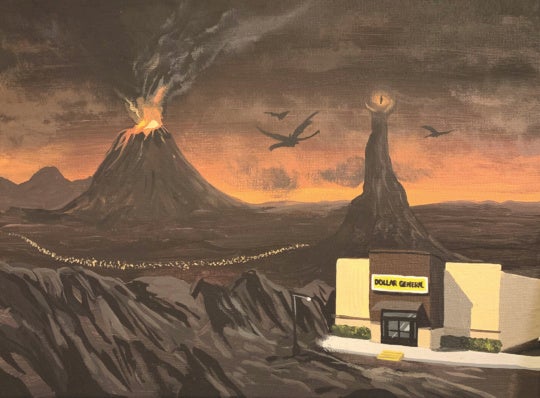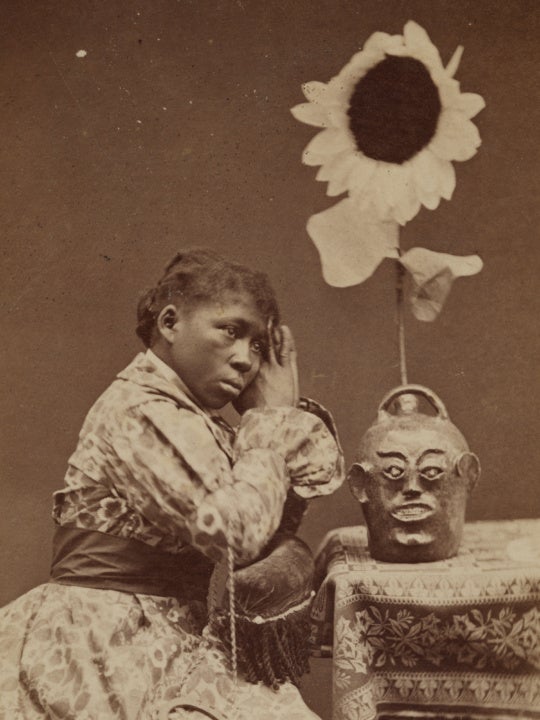
The title of Amber Boardman’s exhibition “Regrowth” at Sandler Hudson, her first in Atlanta in six years (she now lives in Sydney), refers to something inevitable: the appearance of natural hair color at the roots as seen in the titular painting Regrowth. Almost every painting in the exhibition showcases in bold brush strokes all the things women do to “improve” their physical appearance, from dying their hair to plastic surgery. The pursuit of perfection, like the fight against the persistent passing of time as evidenced in Middle Aged Alter Ego, is futile. However, “Regrowth” has other meanings for Boardman. Aside from everyday vanities and embarrassments, the many paintings in this exhibition tell a deeper story. Lurking behind the fruitless attempts at conformity lie self-acceptance, humor, and human empathy.
Boardman’s cartoonish figures range from bulbous, featureless beings (Yoga Trumpet and Labor Blob) to loosely painted portraits with striking expressions, all rendered in thick streaks of oil and acrylic and a garish color palette that define the artist’s eye-catching and textural style. Some of the portrait are irregular diptychs, like the gorgeous Mascara Game Strong, with the figure’s dripping mascara falling onto a second panel below. Many paintings are on the small side, hardly larger than a sheet of printer paper. They dot the walls of Sandler Hudson Gallery in a haphazard arrangement reminiscent of family portrait walls in the hallways of many a grandparents’ house.
It’s hard to know whether to laugh or cry at Boardman’s paintings. The titles often act as a punchline, as in Can’t Even and Actually, Fuck Ballet. Other’s seem downright goofy, like Disapproving Baby, who scowls at the viewer, or lean into the absurd, as in Gingerbread on Vacation — a gingerbread woman backed by a glowing sunset. The characters in the collection often seem to be wrestling with societal expectations of beauty — untamable hair, bad skin, and bad makeovers plague this crew of hopeless misfits. However, the exhibition never feels cruel. Boardman isn’t making fun of them, she’s empathizing. Even if she hadn’t put herself in the shoes of these insecure, nervous people (sometimes literally, as there are self-portraits in the exhibition), the works come off as more playful or sympathetic than condescending.

Certain paintings stand out from the cluster, and not necessarily because they’re funny or quirky. Facelift Addiction, with its highly contorted, abstract face dotted with pink streaks for cheeks and an unnerving, skull-like nose, is a frightening cautionary tale. Laborblob, which depicts a faceless, armless, footless beige blob with one hooked leg slightly raised atop a hospital gurney, conveys feelings of helplessness and dangerous vulnerability.

In the end, most of Boardman’s creations are both a little funny and little scary. Makeover Magic could make us chuckle because it shows a woman with zombielike blue eyes, electrified hair, and over-the-top rouge and lipstick. At the same time, all these characters consumed by unrealistic beauty standards are uncomfortable reminders of the slow-dying patriarchal system and our own deeply internalized misogyny that dictates them.

While Boardman is certainly aware of these absurd systems of oppression, she doesn’t leave her creations to despair. Through her wild brush strokes, vibrant palette, and empathetic humor comes a kind of deranged joy. Boardman breaks and reconstructs traditional structures of representation by demonstrating a keen awareness of her own insecurities, and the insecurities of others. To view Boardman’s work, hung haphazardly across the wall like pictures of our own family, is to experience something communal and strangely therapeutic. Rather than feeling depressed after spending time in the exhibition, I walked out of the gallery feeling rather buoyant and liberated. Suddenly, skipping that next wax appointment seems like a great idea.
“Amber Boardman: Regrowth” is on view at Sandler Hudson Gallery through October 21.
E.C. Flamming is an Atlanta-based writer. She has been published in ART PAPERS, Paste, ArtsATL, and The Peel Literature & Arts Review.




